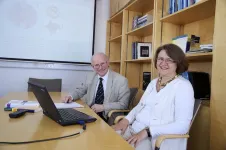(Press-News.org) There is a relative increase of 20% to 30% in breast cancer risk associated with both combined and progesterone-only contraceptives, whatever the mode of delivery, though with five years of use, the 15-year absolute excess incidence is at most 265 cases per 100,000 users. The results appear in a new study publishing March 21st in the open access journal PLOS Medicine by Kirstin Pirie of University of Oxford, UK, and colleagues.
Use of combined oral contraceptives, containing both estrogen and progestogen, has previously been associated with a small increase in breast cancer risk but there is limited data about the effect of progestogen-only hormonal contraceptives. However, the use of progestogen-only contraceptives has increased substantially in recent years, with almost as many prescriptions in England for oral progestogen-only contraceptives as for combined oral contraceptives in 2020.
In the new study, researchers analyzed data from a UK primary care database, the Clinical Practice Research Datalink (CPRD), on 9,498 women under the age of 50 with invasive breast cancer diagnosed in 1996-2017, as well as data on 18,171 closely matched controls.
On average, 44% of women with breast cancer and 39% of matched controls had a hormonal contraceptive prescription, with about half the prescriptions being for progestogen-only preparations. With five years use of either oral combined or progestogen-only contraceptives, the associated 15-year absolute excess incidence of breast cancer was estimated at 8 cases per 100,000 hormonal contraceptive users at age 16-20 years and 265 cases per 100,000 users at age 35-39 years. The odds of breast cancer were similarly and significantly raised, regardless of whether the contraceptive used was a combined (estrogen and progestogen) oral preparation (OR=1.23 95%CI 1.14-1.32, p<0.001), a progestogen-only oral preparation (OR= 1.26 95% CI 1.16-1.37, p<0.001), an injected progestogen (OR= 1.25 95% CI 1.07-1.45, p=0.004), or a progestogen releasing intra-uterine device (OR=1.32 95% CI 1.17-1.49, p<0.001). These results were combined with those from previous studies from high income countries, which included women from a wider age range.
Pirie adds, “These findings suggest that current or recent use of all types of progestogen-only contraceptives is associated with a slight increase in breast cancer risk, similar to that associated with use of combined oral contraceptives.”
“Given that the underlying risk of breast cancer increases with advancing age, the absolute excess risk associated with use of either type of oral contraceptive will be smaller in women who use it at younger rather than at older ages,” the authors state. “These excess risks must, however, be viewed in the context of the well-established benefits of contraceptive use in women's reproductive years.”
#####
In your coverage, please use this URL to provide access to the freely available paper in PLOS Medicine: http://journals.plos.org/plosmedicine/article?id=10.1371/journal.pmed.1004188
Citation: Fitzpatrick D, Pirie K, Reeves G, Green J, Beral V (2023) Combined and progestagen-only hormonal contraceptives and breast cancer risk: A UK nested case–control study and meta-analysis. PLoS Med 20(3): e1004188. https://doi.org/10.1371/journal.pmed.1004188
Author Countries: United Kingdom, Australia
Funding: Central data collection, checking, analysis, and manuscript preparation (DF, KP, GR, JG, VB) was supported by the core funding of the Cancer Epidemiology Unit by Cancer Research UK (C570/A16491 and A29186) and the Medical Research Council (MR/K02700X/1). DF was funded through the Rhodes Trust. The funders had no role in study design, data collection, analysis, decision to publish, or preparation of the manuscript.
END
CONTENT UPDATED 3/17 - note new references to cardiac rehabilitation.
Statement Highlights:
A new scientific statement indicates supervised exercise therapy may help improve symptoms for people with one of the most common types of heart failure, known as heart failure with preserved ejection fraction (HFpEF), in which the heart muscle’s pumping strength is intact.
Exercise therapy had comparable or better results on improving exercise capacity for people with preserved EF compared to those who have heart failure with reduced ...
Regina Bateson, an Assistant Professor in the Faculty of Social Science’s Graduate School of Public and International Affairs, details the findings of her study, which shows the significant social and economic impacts to individuals who were out of work during the COVID-19 pandemic.
Below she answers questions about her study.
Question: How was this research performed?
Regina Bateson: “In this study, I conducted a pre-registered survey experiment with a nationally representative sample of 974 U.S. adults. ...
A new nano-barrier coating could help protect ultra-lightweight carbon composite materials from extreme conditions in space, according to a study from the University of Surrey and Airbus Defence and Space.
The new functionality added to previously developed ‘space skin’ structures adds a layer of protection to help maintain space payloads while travelling in space, similar to having its very own robust ultralight protective jacket.
The research team has shown that their innovative nano-barrier would help drastically increase the stability of carbon fibre materials, while reducing radiation ...
An international study led by the Molecular Physiology Laboratory at the UPF Department of Medicine and Life Sciences (MELIS) identifies new genes that modulate the toxicity of the protein β-amyloid, responsible for causing Alzheimer’s disease. Combining molecular biology, genomics and bioinformatics techniques, 238 amyloid toxicity protective or activator genes have been identified. Among them, the gene Surf4 stands out. It is involved in the control of intracellular calcium and, by increasing the toxicity of the β-amyloid protein, contributes to the disease.
The research has been carried out thanks to the support ...
Plants use photosynthesis to harvest energy from sunlight. Now researchers at the Technical University of Munich (TUM) have applied this principle as the basis for developing new sustainable processes which in the future may produce syngas (synthetic gas) for the large-scale chemical industry and be able to charge batteries.
Syngas, a mixture of carbon monoxide and hydrogen, is an important intermediate product in the manufacture of many chemical starter materials such as ammonia, methanol and synthetic hydrocarbon fuels. "Syngas is currently made almost exclusively using fossil raw materials," ...
An international team led by Lancaster University has discovered how electrons can slither rapidly to-and-fro across a quantum surface when driven by external forces.
The research, published in Physical Review B, has enabled the visualisation of the motion of electrons on liquid helium for the first time.
The experiments, carried out in Riken, Japan, by Kostyantyn Nasyedkin (now at Oak Ridge National Laboratory, USA) in the lab of Kimitoshi Kono (now in Taiwan at Yang Ming Chiao Tung University) detected unusual oscillations whose frequencies varied in time. Although it was unclear how ...
Argonne received $3.5 million in funding to help accelerate battery production in America, lower costs, provide a domestic source of materials and reduce the environmental impact of electric vehicle batteries.
Batteries are critical to powering a clean energy economy. This is especially true in the transportation sector, where electric vehicles (EVs) are on track to make up half of all new vehicle sales by 2030. In order to meet this rapidly increasing demand, the U.S. Department of Energy (DOE) is distributing funding to advance domestic recycling and reuse of electric vehicle batteries. Managed by DOE’s Vehicle ...
If you’ve ever been admitted to hospital or visited an emergency department, you’ve likely had an electrocardiogram, or ECG, a standard test involving tiny electrodes taped to your chest that checks your heart’s rhythm and electrical activity.
Hospital ECGs are usually read by a doctor or nurse at your bedside, but now researchers are using artificial intelligence to glean even more information from those results to improve your care and the health-care system all at once.
In recently published findings, the research team built and trained machine learning programs based on 1.6 ...
The Science
Protons and neutrons, the building blocks of atomic nuclei, are themselves made up of strongly interacting quarks and gluons">quarks and gluons. Because the interactions are so strong, the structure of protons and neutrons is difficult to calculate from theory. Instead, scientists must measure it experimentally. Neutrino experiments use targets that are nuclei made of many protons and neutrons bound together. This complicates interpreting those measurements to infer proton structure. ...
In humanity’s ongoing quest for the elixir of life, the science keeps pointing to stem cells. Research increasingly shows that maintaining stem cell fitness promotes a long healthspan, and new findings show keeping stem cells clean and tidy is an integral step.
In a study published March 21, 2023 in Cell Stem Cell, researchers at University of California San Diego School of Medicine found that blood stem cells use an unexpected method to get rid of their misfolded proteins, and that this pathway’s ...







